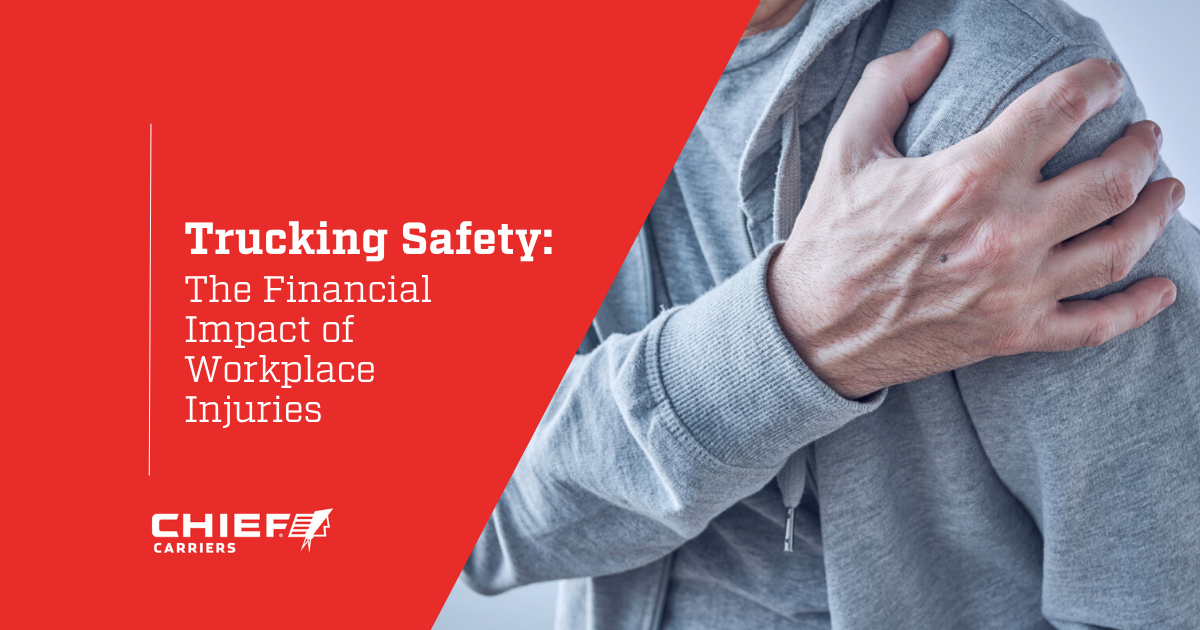The High Cost of Workplace Injuries in Trucking
Truck drivers are the backbone of our economy, delivering essential goods across vast distances and ensuring businesses thrive. However, their demanding profession carries significant risks, and a workplace injury can instantly derail their livelihood. When an accident occurs, the repercussions impact the driver, their family, and the economy they serve.
With over 50 years of experience in flatbed trucking, Chief Carriers understands the challenges that injured truck drivers face. We’ll explore the significant financial impact of workplace injuries in the trucking industry, highlighting the direct and indirect costs to truck drivers and their families.

Understanding the Direct Costs of Workplace Injuries for Truckers and Companies
When a truck driver sustains an injury on the job, there are direct costs of workplace injuries that are incurred. These are the immediate, measurable expenses that often come to mind first.
Medical Expenses
The most apparent direct cost is medical care, which can encompass a wide range of services, including:
- Emergency care: Ambulance services, emergency room visits, and immediate medical stabilization.
- Hospital stays: For more severe injuries, prolonged hospitalization may be necessary.
- Surgeries: Complex injuries often require surgical intervention.
- Medications: Prescriptions for pain management, antibiotics, and other necessary drugs.
- Rehabilitation: Essential therapies, such as physical therapy for soft tissue injury recovery, occupational therapy, and chiropractic care, are crucial for a driver to regain functionality.
RELATED: Truck Driver Health: Why Your Wellness Matters

Workers’ Compensation Payments
Workers’ compensation provides injured workers with medical care and partial wage replacement, typically covering approximately two-thirds of their pre-injury earnings. However, this still leaves a significant financial gap, shifting a portion of the burden onto the injured truck driver.
Legal Fees
Workplace injuries can result in legal disputes, creating substantial legal fees for both the injured driver and the trucking company. These escalating costs significantly add to the overall financial impact of workplace injuries.
Property Damage
In incidents involving accidents or equipment malfunction, there may be significant property damage to the truck itself, cargo, or other property involved. The repair or replacement costs for damaged vehicles and goods contribute directly to the company’s costs associated with workplace injuries.
RELATED: Flatbed Load Securement: Ensuring Safety and Compliance

Indirect Costs of Workplace Injuries
While direct costs are relatively easy to quantify, the indirect costs of workplace injuries are often overlooked. However, these hidden burdens can accumulate significantly, sometimes exceeding direct costs and having a prolonged impact on both the driver and the company.
Lost Productivity and Wages for the Driver and the Company
Beyond partial workers’ compensation, losing full truck driver wages is devastating. It causes the driver financial stress by significantly impacting their ability to cover daily expenses and support their families.
You’re not going to earn a full paycheck while you’re sitting at home on the couch, going to physical therapy… It’s about two-thirds of your average wage.
-Andrew Winkler, General Manager of Chief Carriers
For the company, an injured driver means an unoperated truck, delays in deliveries, and a direct reduction in overall operational efficiency. This can result in missed deadlines, dissatisfied clients, and far-reaching consequences for the business.

Hiring and Training Replacement Drivers
When a driver is out of commission, companies face immediate workforce expenses to find a replacement. This includes recruitment costs such as:
- Advertising
- Interviewing
- Background checks
Additionally, training new or temporary drivers demands significant time and resources for onboarding and familiarization with company policies and routes, a particular challenge given the current demand for skilled drivers.
Administrative and Investigative Costs
Every workplace injury triggers a series of administrative tasks and investigations that take time, resources, and personnel away from day-to-day operational areas. Costs are incurred for tasks that may include:
- Incident investigation, which can involve safety personnel, managers, and external experts.
- Paperwork such as workers’ compensation claims, insurance reports, and internal documentation.
- Complex and time-consuming compliance reporting
Increased Insurance Premiums
A history of workplace injuries directly impacts a company’s insurance rates. Each claim, particularly those involving significant medical expenses or lost time, can result in higher workers’ compensation premiums. A poor safety record signals increased risk to insurers, translating into escalated costs of workplace injuries for the company over the long term.

Decreased Employee Morale and Turnover
Workplace injuries can cast a shadow over the entire team. Witnessing a colleague’s injury or dealing with the aftermath can decrease morale if other drivers feel less safe, more stressed, and less engaged.
Turnover may increase as drivers might seek employment with companies perceived as having better safety records, leading to the added expense of constantly recruiting and training new personnel.
RELATED: The Impact of Driver Turnover: Why Truck Driver Retention Matters
Reputational Damage
A poor safety record can significantly damage a trucking company’s image on multiple fronts. Potential clients may be hesitant to work with a company with a reputation for frequent accidents or injuries, and skilled drivers are more likely to seek employment with companies that prioritize truck driver safety.

The Impact on Truck Drivers and Their Families
Beyond the financial metrics, the human element of workplace injuries is paramount. Truck drivers and their families often face profound personal struggles after the driver suffers an on-the-job injury.
Loss of Income and Financial Strain
Even with workers’ compensation, the reduction in truck driver wages creates immense financial strain. Daily living expenses, mortgages, and family budgets are in jeopardy, often creating increased financial stress for drivers. Their families also face difficult decisions as they struggle to make ends meet.
If you’re already feeling like you’re living paycheck to paycheck, and all of a sudden your wages are going to be cut by one-third, that’s going to bring some additional stress to you and the family.
-Andrew Winkler
Emotional and Psychological Toll
The impact of a workplace injury extends beyond the physical effects to other parts of a driver’s life. After being injured, drivers often experience issues with their mental health and meaningful relationships, such as:
- Stress, anxiety, and depression: Dealing with pain, limitations, uncertainty about the future, and overwhelming financial worry can severely impact mental health.
- Impact on family dynamics and relationships: An injured driver’s inability to participate in family activities, coupled with new caregiving responsibilities for other family members, can lead to strained family dynamics.

Long-Term Health Consequences
Some injuries result in chronic pain, permanent disability, or the need for ongoing medical care for years — possibly even a lifetime. This can include continuous physical therapy, medication, and specialist visits, all of which add to the long-term cost of workplace injuries and significantly impact the driver’s quality of life.
Career Limitations
For individuals with severe injuries, a career as a truck driver may no longer be feasible. This necessitates a difficult and often daunting career change, requiring retraining, job searching, and a potential reduction in earning potential. Navigating long-term disability for truck drivers after an injury becomes a critical, often complex, process.
If trucking is your life and you love being a truck driver, and all of a sudden, this injury knocks you out of that career — what kind of stress is that going to put on you?
-Andrew Winkler

Prioritizing Truck Driver Safety for Financial Stability
Prioritizing truck driver safety isn’t just a matter of compliance — it’s a strategic imperative leading to a more stable, efficient, and profitable trucking industry. Investing in robust safety programs, ergonomic improvements, and proactive maintenance significantly reduces the cost of workplace injuries, protecting drivers and securing a healthier future for the trucking community.
Chief Carriers stands as a leader in the flatbed trucking industry, with over 50 years of experience and a strong focus on keeping our drivers safe both on and off the road.
We invite you to learn more about this topic by hearing what our General Manager, Andrew Winkler, shares in the Driven Too Far podcast episode, “Injury Aftermath: The True Financial Hit to Families.”

